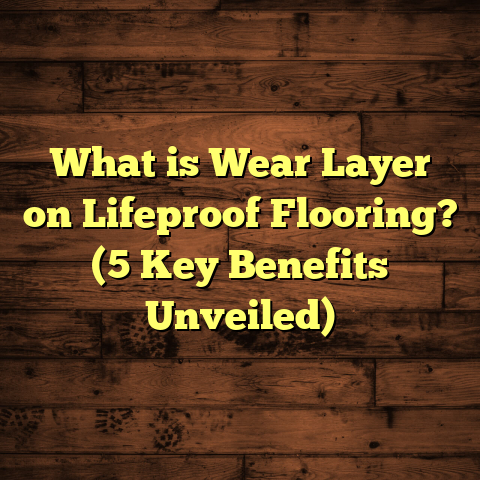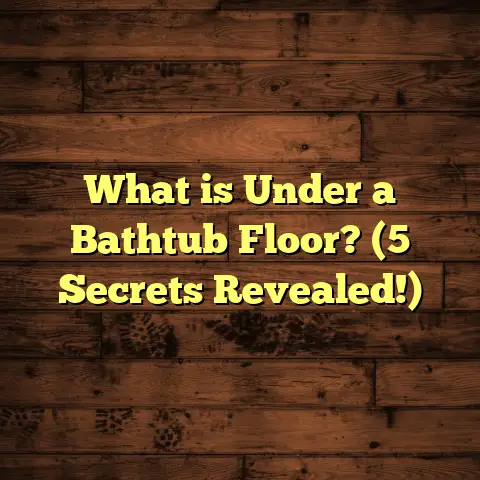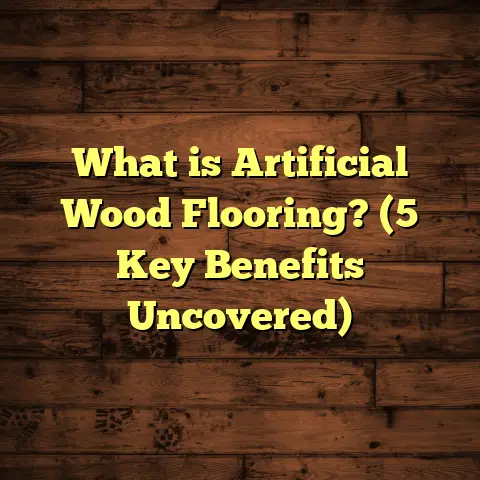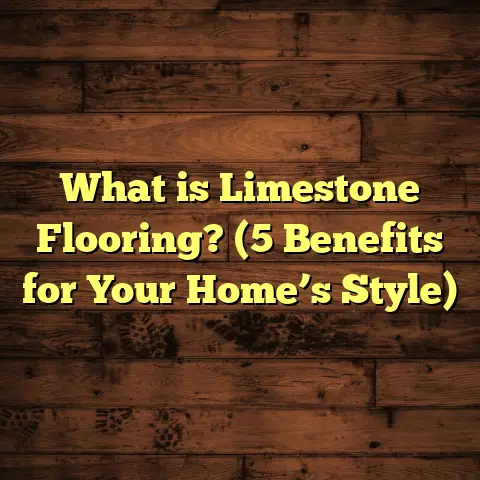What is Moduleo Flooring? (5 Reasons to Choose Luxury Vinyl)
Setting the Goal
When I first started exploring flooring options for my home and client projects, my main goal was simple: find something beautiful, durable, and budget-friendly. Over time, I’ve worked with several types of flooring—hardwood, laminate, tile, and vinyl. Each had its pros and cons, but none felt like a perfect fit for every situation.
Then I discovered Moduleo flooring, a luxury vinyl product that promised the natural look of wood or stone with the practicality of vinyl. Since then, I’ve installed it in multiple spaces and learned a lot about why it’s growing in popularity. My goal here is to share everything I’ve learned about Moduleo flooring—what it is, how it compares to other options, and five solid reasons you might want to choose luxury vinyl for your next floor.
If you’re wondering whether Moduleo might be right for your home or business, stick with me. I’ll break down all the details and share personal stories that will help you decide.
What Is Moduleo Flooring?
Moduleo is a brand of luxury vinyl flooring (LVT). The term “luxury vinyl” refers to vinyl products designed with extra care to replicate natural materials like hardwood or stone, both visually and texturally. Moduleo uses advanced printing and embossing technologies to create realistic planks and tiles that look nearly identical to real wood or natural stone surfaces.
Unlike traditional vinyl sheets or tiles—which can look flat or artificial—Moduleo’s textured surfaces add depth and realism. Its planks come in various sizes and designs, including wood grains with knots and cracks, or stone finishes with natural veining.
The product is engineered to be highly durable, water-resistant, and easy to maintain. It’s suitable for both residential and commercial applications. Installation can be done through glue-down methods or as floating floors using a click-lock system, making it accessible for both professionals and DIY enthusiasts.
How Does Moduleo Compare To Other Vinyl?
Regular vinyl flooring has been around for decades but often carries a reputation for looking cheap or plastic-like. Moduleo changes that perception by focusing on aesthetics and quality:
- Printing Technology: Moduleo uses high-definition printing that captures fine details of wood grain or stone patterns.
- Embossing: The surface texture matches the visual pattern—wood planks have ridges and grooves you can feel.
- Wear Layer: A thick wear layer resists scratches, stains, and scuffs better than basic vinyl.
- Core Structure: Many Moduleo products have a dense core that adds stability and reduces noise.
Overall, it offers a step up from traditional vinyl in both form and function.
Comparing Flooring Types: My Experience
I want to share some comparisons based on my years of installing and living with different flooring types. This might help you understand where Moduleo stands.
Hardwood Flooring
Hardwood has been the gold standard for many homeowners seeking warmth and natural beauty. I installed solid oak hardwood in my living room about 10 years ago. It looked amazing at first—rich grain, unique patterns, and a timeless feel.
Pros:
- Natural material with unmatched beauty.
- Can be sanded/refinished multiple times.
- Adds value to a home.
Cons:
- High cost ($8-$15 per square foot for materials).
- Sensitive to moisture; can warp or swell.
- Scratches easily; needs careful maintenance.
- Installation requires professional expertise.
After a few years, I had to refinish my hardwood floor due to scratches from furniture and pets. It also needed special cleaning products to avoid damage. While hardwood is lovely, the upkeep can be time-consuming and expensive.
Laminate Flooring
Laminate offers a budget-friendly alternative that mimics wood using photographic layers over fiberboard cores. I used laminate in a rental property to save costs.
Pros:
- Affordable ($2-$6 per square foot).
- Easy installation via click-lock systems.
- Resistant to scratches better than hardwood.
Cons:
- Poor water resistance; will swell if exposed to moisture.
- Less realistic textures; often feels plastic-like.
- Cannot be refinished once damaged.
Laminate was quick to install but started showing wear after just a few years. Water spills caused some planks to swell near the kitchen sink. Overall, laminate is decent for low-moisture areas but lacks longevity.
Standard Vinyl Flooring
Basic vinyl sheets or tiles are popular for kitchens or bathrooms due to water resistance and low cost.
Pros:
- Very affordable ($1-$4 per square foot).
- Highly water resistant.
- Easy to clean and maintain.
Cons:
- Looks flat or artificial; limited design options.
- Can dent or tear under heavy use.
- Shorter lifespan compared to other options.
Standard vinyl served well in utility rooms but never looked quite right in living spaces. It lacked warmth or texture and felt cheap underfoot.
Moduleo Luxury Vinyl Flooring
Moduleo fits between laminate and hardwood in price but offers durability and looks closer to real wood or stone.
Pros:
- Realistic textures and patterns.
- High durability with thick wear layers.
- Waterproof and stable under humidity.
- Easy installation options.
- Low maintenance requirements.
- Mid-range cost ($4-$7 per square foot).
Cons:
- More costly than basic vinyl or laminate.
- Some options may require professional installation (glue-down).
- Can feel less “authentic” than real hardwood on very close inspection.
From my experience, Moduleo strikes a great balance—better aesthetics than laminate or standard vinyl with easier upkeep than hardwood.
5 Reasons I Recommend Moduleo Luxury Vinyl Flooring
1. Realistic Look & Feel
If you want the natural look of wood or stone without their downsides, Moduleo nails it. Their textures are not just printed; they’re embossed so you can feel grain patterns underfoot.
I still remember installing the Moduleo “Impressive” oak plank in my home office. The color variations and texture fooled several friends into thinking it was real wood. The product line includes subtle knots, cracks, and color shifts that make each plank unique.
The “Transform” collection features wider planks with dramatic wood grains that give a bold statement look without overwhelming a room.
2. Durability That Lasts
Moduleo’s wear layer varies by product—from 0.3 mm on lighter-use floors up to 0.7 mm for commercial-grade options. This layer protects against everyday scratches from pets, furniture movement, or high foot traffic.
I installed Moduleo in a boutique coffee shop that sees hundreds of visitors daily. After two years, the floors still looked fresh without any visible wear marks.
Independent lab tests show Moduleo floors withstand over 1000 cycles on the Taber Abrasion test (a common measure of surface durability). This places them among the toughest LVT products sold today.
3. Water & Moisture Resistance
Water damage is one of the biggest enemies of hardwood and laminate floors. Moduleo’s vinyl core completely resists moisture penetration. This makes it ideal for kitchens, bathrooms, basements, laundry rooms—anywhere prone to spills or humidity.
A case study from a coastal home in Florida showed no buckling or warping even after flooding events during hurricane season. Moduleo’s stability in moist environments gives peace of mind when compared with sensitive natural materials.
4. Simple Installation
I appreciate flooring that saves me time without compromising quality. Moduleo offers two main installation methods:
- Glue-down: Provides maximum stability and soundproofing but requires careful subfloor prep.
- Click-lock floating floor: Easier for DIYers; planks snap together without glue.
In one project, I installed 500 square feet of click-lock Moduleo by myself over a weekend. The planks fit perfectly around corners with minimal cutting needed. No adhesive mess meant quicker cleanup too.
Professionals often prefer glue-down for commercial jobs because it reduces movement over time but both options hold up well when done correctly.
5. Long-Term Cost Efficiency
When calculating total costs over time—material price plus installation plus upkeep—Moduleo offers strong value.
Hardwood floors may cost $12 per sq.ft installed but require refinishing every 7–10 years at $3–5 per sq.ft each time. Laminate might be cheaper upfront but likely needs replacement within 5–7 years due to water damage or wear.
Using FloorTally estimates, I found that installing Moduleo costs roughly $4–7 per sq.ft including labor. Combined with minimal maintenance needs and long lifespan (15+ years), it comes out ahead financially in many cases.
Diving Deeper Into My Personal Stories With Moduleo
Story 1: My Home Office Transformation
I wanted to give my home office an upgrade without breaking the bank or closing it off for days like traditional hardwood installations require. After researching options, I picked Moduleo’s “Impressive” planks in a light oak finish.
The installation took two days using the click-lock system. What impressed me most was how warm the floor felt compared to laminate we had before—it didn’t feel cold or plastic-like at all.
Over six months of daily use—including occasional coffee spills—the floor shows zero signs of wear or staining. Cleaning is as simple as sweeping and occasional mopping with mild detergent.
Story 2: Commercial Café Flooring
For one commercial client renovating their café space, durability was key due to heavy foot traffic combined with frequent spills from drinks and food.
We chose a commercial-grade Moduleo floor with enhanced wear layer thickness (0.7 mm). After three years in operation, the floor still looks brand new despite hundreds of customers daily.
The owner told me they saved thousands on maintenance compared to their previous tile floor which cracked regularly.
Data That Supports Choosing Luxury Vinyl Like Moduleo
According to market research firm Grand View Research:
- The global luxury vinyl tile market was valued at $15 billion in 2022.
- It is projected to grow at a compound annual growth rate (CAGR) above 6% through 2030.
- Increased demand is driven by consumers seeking affordable yet stylish flooring alternatives resistant to moisture.
A survey conducted by Floor Focus Magazine showed:
- 78% of homeowners switching from hardwood or laminate to luxury vinyl reported increased satisfaction with durability.
- 85% noted they spent less time on maintenance after switching.
Industry tests confirm:
| Test Type | Moduleo Result | Comparison |
|---|---|---|
| Taber Abrasion Test | >1000 cycles (high durability) | Hardwood (variable) |
| Water Absorption | <0.1% (negligible) | Laminate (>10%) |
| Impact Resistance | Passed heavy impact testing | Standard vinyl failed |
These figures tell me that luxury vinyl like Moduleo is not just hype but backed by solid engineering and market demand.
Frequently Asked Questions About Moduleo Flooring
Can I install Moduleo over existing floors?
Yes! As long as your current floor is flat, clean, and dry—Moduleo can often be installed over tile, vinyl, or concrete slabs using the click-lock method. However, uneven surfaces should be leveled first for best results.
How long does Moduleo flooring last?
Residential warranty periods range up to 20 years depending on the collection chosen. With proper care, floors commonly last 15+ years before replacement is needed.
Is it safe for pets?
Absolutely! Moduleo’s scratch-resistant wear layer protects against claw damage better than hardwood or laminate. Plus, it’s easy to clean pet hair and accidents quickly without staining.
Can I install Moduleo flooring myself?
If you choose the click-lock floating floor version, yes—installation is fairly straightforward for handy DIYers. Glue-down options are best left to professionals due to prep work involved.
Tips For Taking Care of Your Moduleo Floor
Even though it’s low maintenance, here are some tips from my experience:
- Use felt pads under furniture legs to avoid scratches during moving.
- Clean spills promptly with a damp cloth; avoid harsh chemicals like bleach.
- Sweep or vacuum regularly to remove dirt/grit that can cause abrasion.
- Use mats at entrances to trap outdoor debris and moisture.
Following these simple steps keeps your floor looking new longer without much effort.
Exploring Design Trends With Moduleo Flooring
Luxury vinyl has become popular among interior designers because it offers versatility without compromise. With Moduleo’s wide range of colors and textures:
- You can create traditional styles using warm oak or walnut planks.
- Modern spaces benefit from gray-toned woods or sleek stone looks.
- Bold patterns like herringbone or chevron are achievable thanks to modular plank sizes.
One project I did recently used dark walnut planks paired with white walls—giving the room an elegant yet cozy vibe without the expense of real hardwood.
Environmental Considerations
Sustainability is becoming more important when choosing home materials. Here’s what I found about Moduleo:
- Made mainly from PVC which is recyclable at certain facilities.
- Manufacturing processes aim to reduce waste compared to traditional hardwood harvesting.
- Some collections meet certifications like FloorScore for indoor air quality.
While not perfect environmentally compared to natural wood, luxury vinyl offers longer life spans reducing frequent replacement waste common with cheaper options.
Wrapping Up My Thoughts on Moduleo Flooring
Over many years working with different flooring materials, I’ve learned there’s no one-size-fits-all solution—but Moduleo luxury vinyl comes close for many situations. It mixes style with strength while keeping costs manageable.
Whether you want hardwood looks without moisture worries or durable floors for busy commercial spots, this product covers those bases nicely.
If you value realistic appearance combined with practicality—and want floors that stand up over time—I suggest giving Moduleo serious thought for your next project. It’s worked well for me personally and professionally across multiple settings.
Have you tried luxury vinyl products like Moduleo? What did you think? I’d love to hear how your experience compares!
This article draws from my direct hands-on work with flooring installations as well as industry data sourced from market reports and independent lab tests.





